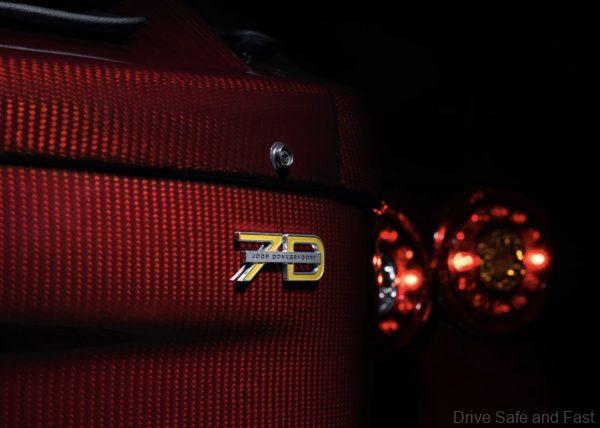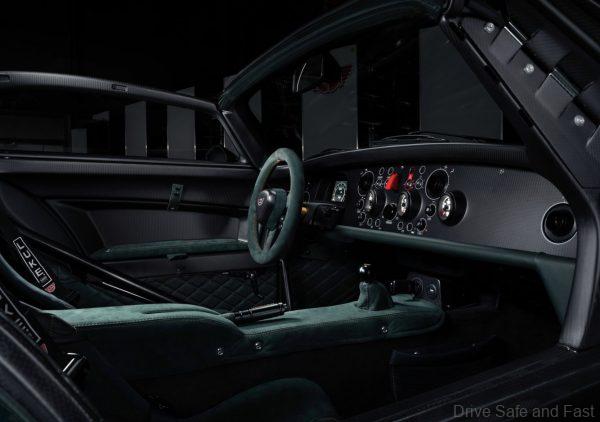Another Donkervoort Gets the ‘Bare Naked Carbon’ Treatment
Donkervoort Automobielen, the Dutch outfit that hand builds ultra light sports cars, has a new “Bare Naked Carbon Edition” of the D8 GTO-JD70. The D8 GTO-JD70 was specially made to commemorate the 70th birthday of the company’s founder, Joop Donkervoort.
It’s the fastest vehicle the company produces, with a turbocharged 2.5-litre 5-cylinder Audi motor making 415bhp and 520Nm of torque. This power is sent to the rear wheels via a close-ratio 5-speed manual gearbox. The Donkervoort D8 GTO-JD70 is made for fast cornering, and is able to deliver 2Gs of lateral g-forces through corners.

This Bare Naked Carbon Edition offers its customers four levels of carbon-fibre exposure. This ranges from “exposed carbon upgrade” to “full exposed carbon”. Exposed carbon can be finished in either matte or gloss clear coating.
When fully exposed, carbon can be finished in green, red, blue, gold and grey, and metallic. Here’s a promotion video for this particular car:
Here’s the press release with more information.
PRESS RELEASE
Donkervoort Automobielen has taken the clothes off its D8 GTO-JD70 with the long-planned Bare Naked Carbon Edition (BNCE).
Available with either clear or coloured lacquer, the Bare Naked Carbon Edition gives the JD70 a stunning, high-art texture and highlights the precision of Donkervoort’s carbon-fibre expertise, all while making the 700kg car several kilograms lighter.
JD70s with BNCE technology can be delivered in a raw, naked carbon look or with a coloured lacquer coating in either matte or polished finishes.
The first production car in the world with 2G of cornering muscle, the JD70 was developed as a tribute for the 70th birthday of Donkervoort founder, Joop Donkervoort. The BNCE, though, has been developed to help personalise every JD70 Donkervoort builds.
BNCE developed to give customers the opportunity to lighten and customize their cars beyond the usual colour palate.
More than 95 percent of the standard JD70 bodywork is in carbon-fibre and the BNCE program, which began in 2018, allows owners to see what they’ve paid for.
The bodywork of the JD70 is made of a carbon-fibre/Kevlar weave and even the cycle wings are carbon fibre/ Kevlar.
The entire front design is now new compared to the GTO-40 and all of the vented pieces are hexagonal in design and they are all made from 3D-printed carbon-fibre.
BNCE
Developed after a request from a customer in 2018, the BNCE idea can be delivered either in either a high gloss or a matte finish.
Donkervoort has delivered several cars with the BNCE bodywork to knowledgeable enthusiasts already, but BNCE is now being made more widely available.
Donkervoort offers its customers four levels of carbon-fibre exposure, from the relatively subtle “exposed carbon upgrade” up to the art package of the “full exposed carbon” option. Exposed Carbon Upgrade: The entry level to the world of visible carbon shows off exposed carbon (in either matte or gloss coats) for the side panels, the engine-bay wings, the bonnet scoop, the triangular cover scoops and the full interior.
Hypercar Carbon Weave for Carbon upgrade pack: This reduces weight thanks to a different fibre weave structure.
Full Exposed-Carbon upgrade: This shows the complete car in exposed carbon, including the exhaust cover. It reduces weight significantly.
Full-Exposed Coloured Carbon: Donkervoort delivers the complete car in coloured carbon, including the sideexhaust cover. It is an upgrade that could be added to the Full Exposed-Carbon upgrade.
Colours for the full, exposed coloured carbon versions are available on request, but so far include green, red, blue, gold and grey, and metallic can be mixed in as well.
THE D8 GTO-JD70
The hypercar-slaying Donkervoort D8 GTO-JD70 legend will smash through the 2G barrier to deliver the astounding cornering ability to match its crushing acceleration.
The JD70 can pull more than 2G of lateral acceleration in corners, even in its standard trim and on its standard Nankang tyres, and more than 1G of acceleration.
It is a supercar for people who ache for the heightened senses and the purity of unfiltered driving experiences, and the JD70 has been designed to allow drivers to form an unshakeable bond with their machines.
It is a comfortable on city streets in heavy traffic as it is on the open road.
The Donkervoort D8 GTO-JD70 starts from €163.636,36 (before taxes). The new final-drive ratio does help to improve the fuel economy. Even with all of this speed, the JD70’s official CO2 emissions figure per kilometre will be just 191 grams.
That won’t be the end of the powertrain story, though, because a strong relationship with Bosch has delivered rev-matching software for downshifts and even added a full-throttle upshift mode for more spirited driving.
POWER WITH CONTROL
The most powerful Donkervoort ever made, the 2.5-litre, in-line five-cylinder motor generates 415bhp (310kW) of power and 520Nm of torque.
The engine delivers its peak torque from only 1750rpm and holds it until 6350rpm – a point in the rev range where most cars are developing their peak power.
Its layout matches that of the previous D8 GTO-40, providing enough engineering familiarity to comfort loyal Donkervoort fans and enough raw performance and character to draw in new customers.
Incorporating a new catalyst system, the exhaust pipe exits the side of the car ahead of the rear wheels, which reduces weight thanks to shorter pipe lengths, and it has also been tuned to deliver an even more emotional engine sound into the car.
It uses a close-ratio, five-speed manual gearbox, which drives a custom-developed limited-slip differential on the rear axle.
The biggest change to the driveline has been the lengthening of the final-drive ratio from 3.63:1 to 3.31:1, to take advantage of the engine’s stronger low-end performance and to provide longer highway legs.
The new final-drive ratio improves the fuel economy, with the JD70 posting a WLTP CO2 emissions figure of just 198 grams per kilometre.
At the core of the JD70 is a hybrid chassis technology that combines a tubular steel ladder frame with carbonfibre for added strength and aluminium to reduce weight in less critical areas.
The wide-track suspension system features a double-wishbone layout and redeveloped three-way adjustable Intrax dampers at each corner.
The coil springs are custom made for Donkervoort and the front and rear anti-roll bars are also adjustable, as is the variable traction-control system.
It uses Tarox wave-pattern 310mm x 24mm discs and six-piston, monobloc calipers at the front and smaller (285mm x 24mm) wave-pattern discs and a single-piston caliper setup in the rear. One of the major changes has been the switch from Toyo to Nankang as the original equipment tyre supplier. The Nankang compound is harder, and delivers longer tyre life, yet it provides more mid-corner grip and helps the JD70 beyond the 2G barrier. The front tyres are 235/45 17 in size, while the rear end uses 245/40 18 tyres. The front tyres wrap around 8 x 17″ forged alloy wheels, while the rear end uses larger 9 x 18″ wheels. Super lightweight carbon-fibre rims are a factory option.























